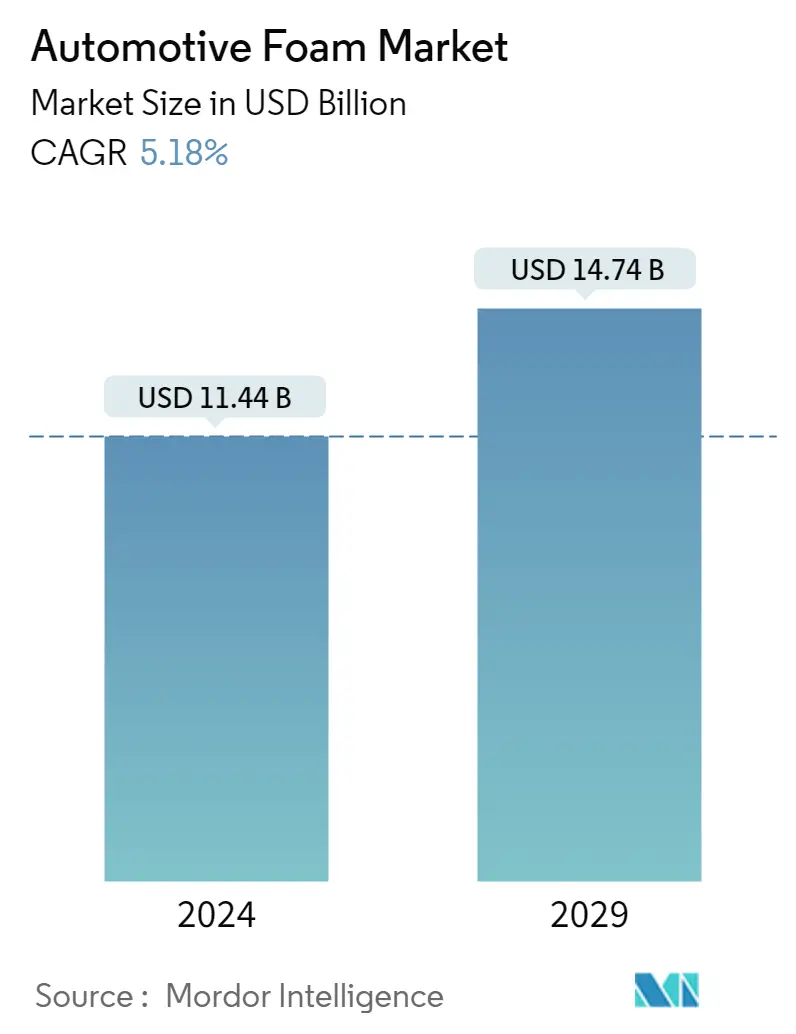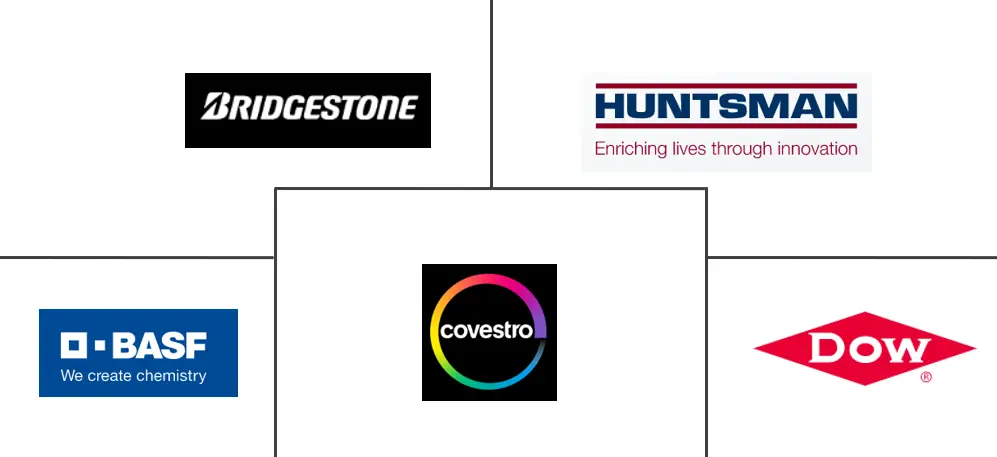Market Size of Automotive Foam Industry

| Study Period | 2019 - 2029 |
| Market Size (2024) | USD 11.44 Billion |
| Market Size (2029) | USD 14.74 Billion |
| CAGR (2024 - 2029) | 5.18 % |
| Fastest Growing Market | Asia Pacific |
| Largest Market | Asia Pacific |
Major Players
*Disclaimer: Major Players sorted in no particular order |
Automotive Foam Market Analysis
The Automotive Foam Market size is estimated at USD 11.44 billion in 2024, and is expected to reach USD 14.74 billion by 2029, growing at a CAGR of 5.18% during the forecast period (2024-2029).
In the year 2020, the breakdown of Covid-19 and the imposition of lockdowns negatively affected the automotive industry causing a decline in sales and production. However, the easing of lockdowns and economies gaining momentum helped the industry to gain back momentum in the years 2021 and 2022.
- Factors such as growing emphasis on the sustainable production of automotive foams and the growing need for weight reduction in vehicles are expected to drive the market over the forecast period.
- However, the availability of eco-friendly bio-foams and the decline in automotive production in major economies of Europe is expected to hinder the market growth over the forecast period.
- The growing demand from electric vehicles and other factors are expected to act as an opportunity for the market over the forecast period.
- Asia-Pacific dominated the market with an increased demand from countries like India, China, and others.
Automotive Foam Industry Segmentation
Automotive foams are used in the automotive industry due to their various properties like sound absorbing, vibration dampening, lightweight, and insulating properties. Various types of foams are used in the manufacturing of car seats, headliners, children's seats, armrests, and door panels. The automotive foam market is segmented by type, application, and end-user industry. By Type, the market is segmented into polyurethane foams (PUFs), expanded polypropylene foam, PET foam, and other types. By application, the market is segmented into interior and exterior. The report also covers the market size and forecasts for the adhesives and sealants market in 15 countries across major regions. For each segment, the market sizing and forecasts have been done on the basis of revenue (USD billion).
| Type | ||||
| ||||
| Expanded Polypropylene Foam | ||||
| PET Foam | ||||
| Other Types |
| Application | |
| Interior | |
| Exterior |
| Geography | |||||||
| |||||||
| |||||||
| |||||||
| |||||||
|
Automotive Foam Market Size Summary
The automotive foam market is poised for significant growth over the forecast period, driven by increasing demand for lightweight materials that enhance vehicle efficiency and reduce emissions. The market is experiencing a resurgence following the disruptions caused by the COVID-19 pandemic, with a focus on sustainable production practices and the growing need for weight reduction in vehicles. Polyurethane foam, in particular, is gaining traction due to its insulation, cushioning, and acoustical properties, making it a preferred choice for various interior applications in both internal combustion engine vehicles and electric vehicles. The rise in electric vehicle production and sales presents a substantial opportunity for market expansion, as these vehicles require advanced materials to meet performance and regulatory standards.
The Asia-Pacific region leads the global automotive foam market, with countries like China and India contributing significantly to demand. The region's dominance is supported by the increasing production and sales of vehicles, including a substantial rise in electric vehicles. Major players in the market, such as BASF SE, Dow, Huntsman International LLC, Covestro AG, and Bridgestone Corporation, are actively investing in research and development to enhance foam applications and sustainability. Recent developments, such as BASF's new laboratory in India and Covestro's introduction of bio-circular feedstock, highlight the industry's commitment to innovation and meeting the evolving needs of the automotive sector. Despite challenges like the availability of eco-friendly bio-foams and declining production in some European economies, the market is expected to continue its upward trajectory, driven by technological advancements and regional growth trends.
Automotive Foam Market Size - Table of Contents
-
1. MARKET DYNAMICS
-
1.1 Drivers
-
1.1.1 Growing Emphasis on the Sustainable Production of Automotive Foams
-
1.1.2 Growing Need for Weight Reduction
-
1.1.3 Other Drivers
-
-
1.2 Restraints
-
1.2.1 Declining Automotive Production in Major Economies of Europe
-
1.2.2 Availability of Eco-Friendly Bio-Foams
-
-
1.3 Industry Value Chain Analysis
-
1.4 Porters Five Forces Analysis
-
1.4.1 Bargaining Power of Suppliers
-
1.4.2 Bargaining Power of Consumers
-
1.4.3 Threat of New Entrants
-
1.4.4 Threat of Substitute Products and Services
-
1.4.5 Degree of Competition
-
-
-
2. MARKET SEGMENTATION (Market Size in Value)
-
2.1 Type
-
2.1.1 Polyurethane Foams(PUFs)
-
2.1.1.1 Flexible Polyurethane Foam
-
2.1.1.2 Rigid Polyurethane Foam
-
-
2.1.2 Expanded Polypropylene Foam
-
2.1.3 PET Foam
-
2.1.4 Other Types
-
-
2.2 Application
-
2.2.1 Interior
-
2.2.2 Exterior
-
-
2.3 Geography
-
2.3.1 Asia-Pacific
-
2.3.1.1 China
-
2.3.1.2 India
-
2.3.1.3 Japan
-
2.3.1.4 South Korea
-
2.3.1.5 Rest of Asia-Pacific
-
-
2.3.2 North America
-
2.3.2.1 United States
-
2.3.2.2 Canada
-
2.3.2.3 Mexico
-
-
2.3.3 Europe
-
2.3.3.1 Germany
-
2.3.3.2 United Kingdom
-
2.3.3.3 Italy
-
2.3.3.4 France
-
2.3.3.5 Rest of Europe
-
-
2.3.4 South America
-
2.3.4.1 Brazil
-
2.3.4.2 Argentina
-
2.3.4.3 Rest of South America
-
-
2.3.5 Middle-East and Africa
-
2.3.5.1 Saudi Arabia
-
2.3.5.2 South Africa
-
2.3.5.3 Rest of Middle-East and Africa
-
-
-
Automotive Foam Market Size FAQs
How big is the Automotive Foam Market?
The Automotive Foam Market size is expected to reach USD 11.44 billion in 2024 and grow at a CAGR of 5.18% to reach USD 14.74 billion by 2029.
What is the current Automotive Foam Market size?
In 2024, the Automotive Foam Market size is expected to reach USD 11.44 billion.

